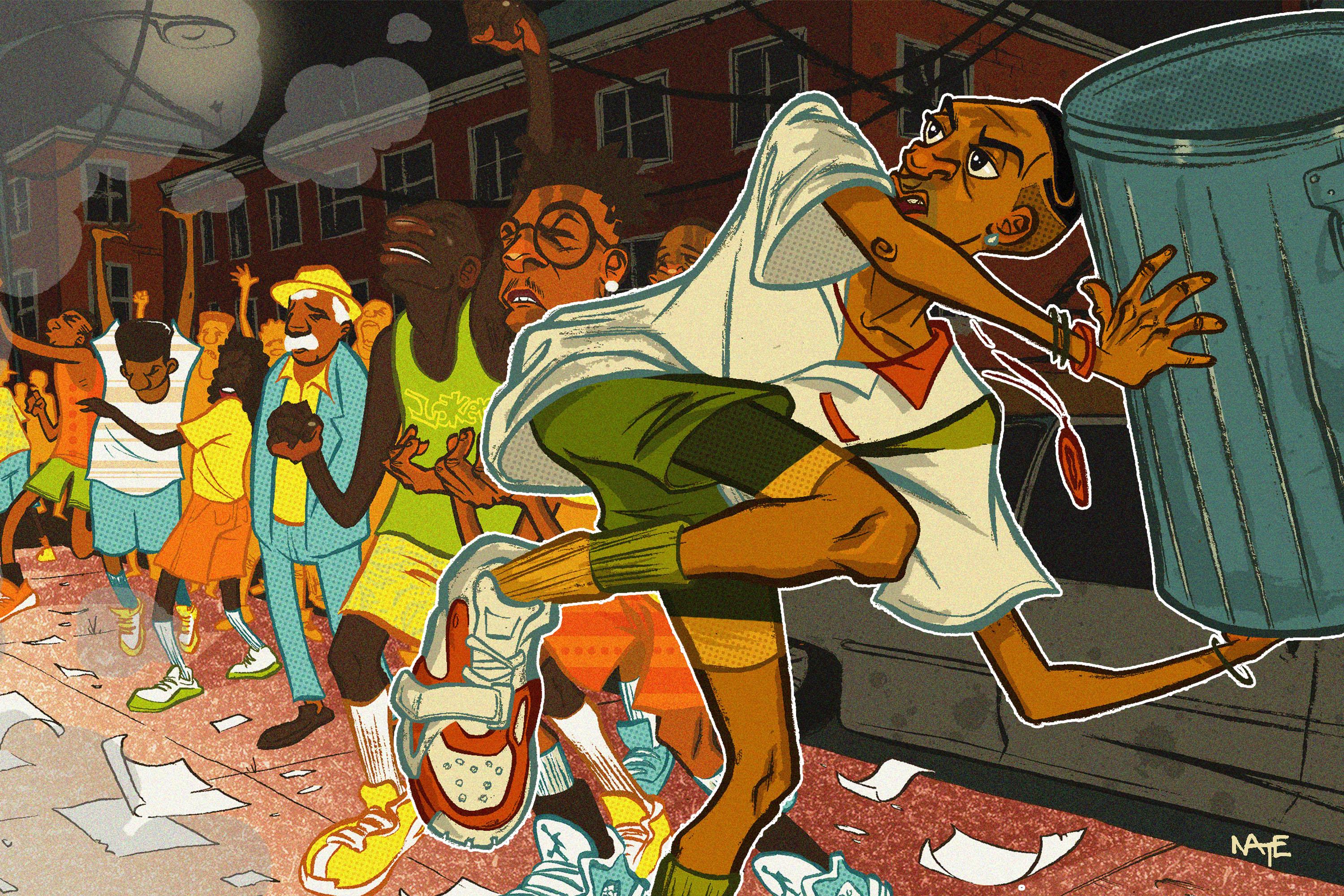Why Mookie Did the Right Thing
The climax of Spike Lee’s seminal film was heavily criticized upon its 1989 release, but the truth is that change in America has never come without a forceful uprisingA week after George Floyd was killed by a white Minneapolis police officer, Spike Lee premiered a short film entitled 3 Brothers on a CNN special hosted by Don Lemon. The film, which is still available on Lee’s Instagram account, is only 94 seconds long. It opens with five words in red juxtaposed against a black background: “Will History Stop Repeating Itself?”
For a minute and a half, footage of the real-life killings of George Floyd and Eric Garner is interspersed with the fictional death of Do the Right Thing’s Radio Raheem (played by the late, great Bill Nunn). All three clips depict unarmed Black men, suffocated and killed by white police officers. Each episode is filled with a chorus of desperate pleas from horrified onlookers. They are eerily similar scenes. Like three instruments playing the same tune in three different octaves.
What makes 3 Brothers so affecting is the morose timelessness of the source material to which it is indebted. Released in 1989, amid the turbulence of the Reagan-and-Bush-era war on drugs, Do the Right Thing is an examination of trauma, community, and uprisings as a form of political action. Starring Lee as the protagonist Mookie, a delivery man at Sal’s Famous Pizzeria—the only white-owned business in the neighborhood—the film takes place over the course of one day, on a single block in Brooklyn’s Bed-Stuy. Set in the midst of a record heat wave, it focuses on the minutiae of everyday life in the neighborhood, only later revealing how vulnerable the Black and Brown bodies that populate it are to police violence.
Lee builds Do the Right Thing into a rolling boil, emphasized by the day’s temperatures but felt especially in Mookie’s interactions. A pair of police officers stalk the neighborhood from their patrol car, like predators eyeing prey. A run-in with a white man in a sweat-stained Larry Bird jersey foreshadows the looming threat of gentrification. A petition, organized by Buggin’ Out (Giancarlo Esposito), demanding that Sal honor not only Italian Americans on his “Wall of Fame” throws Mookie headfirst into fraught debates about race and ownership. Mookie argues with Sal’s oldest son, Pino, a virulent racist, about the inherent contradictions of “hating” Black people while idolizing Black artists and athletes. He protects Da Mayor, an old man with a drinking problem, after police officers question him about a group of kids who’ve sprayed water into a white man’s convertible. Up until the end of the movie, Mookie even tries to mediate the conflict between Sal and Buggin’ Out. For most of the film, he is the bridge between his community and the forces that constrict it.
As the torrid sun gives way to a muggy night, the neighborhood’s tensions overflow. When an altercation breaks out between Radio Raheem and Sal—over the former’s refusal to turn down the volume of his boombox—police officers arrive and immediately subdue Raheem. One officer lifts him off the ground, pinning a billy club against his neck, choking him, until his feet dangle lifelessly in the air. As an uprising swells in response to the killing, Mookie joins in, throwing a trash can through the plate-glass window of Sal’s Famous, after which the pizzeria is burned to the ground. The movie ends with two quotes—one from Martin Luther King Jr. and another from Malcolm X—on the utility of violence as a means to achieve liberation.
Despite its more recent placement within the pantheon of contemporary filmmaking, at the time of its release Do the Right Thing was met with controversy and resistance from white critics. The movie lost out on the Cannes Film Festival’s Palme d’Or because the jury president found Mookie “unheroic.” Nine months later, it was nominated for just two Oscars, famously losing Best Picture to Driving Miss Daisy, a film whose message of racial reconciliation—a well-worn Hollywood trope in which white characters are redeemed of their racism by virtue of their friendship with a Black counterpart—was the antithesis of Lee’s sprawling drama. White critics and Hollywood elites even debated whether or not the film would cause mass rioting in Black communities. In a review for New York magazine, Joe Klein wrote a screed warning readers of the “violent” ramifications that would come if the film spread to Black audiences.
If Lee does hook large black audiences, there’s a good chance the message they take from the film will increase racial tensions in the city. … It is Spike Lee himself—in the role of Sal’s deliveryman—who starts the riot by throwing a garbage can through the store’s window, one of the stupider, more self-destructive acts of violence I’ve ever witnessed (if black kids act on what they see, Lee may have destroyed his career in that moment).
New York magazine’s David Denby, a film critic and current staff writer at The New Yorker, similarly assailed the uprising scene, writing that Lee was “playing with dynamite in an urban playground” and that the “response to the movie could get away from him.”
Beyond the casual racism that suggests Black audiences are incapable of consuming incendiary art without erupting into a rampage of mindless violence, the common thread among the initial criticisms of Do the Right Thing was an ignorance of what “rioting” is about and the manner in which it operates in Lee’s narrative. That same ignorance is as much a staple of moments of social upheaval as the upheaval itself. “Spike was dealing with studio executives that didn’t understand how violence was incited and why it’s incited,” says Ruth E. Carter, the film’s costume designer, who would win an Oscar years later for her work on Black Panther. “They think something as simple as a movie like Do the Right Thing that has a riot scene in it is the thing that tips the temperament of the Black community. But it’s much deeper than that.”
About two-thirds of the way through Where Do We Go From Here: Chaos or Community, the final text that Dr. Martin Luther King Jr. wrote during his tectonic life, King describes visiting Watts, California, in the wake of the infamous 1965 Watts Rebellion. Just a few days earlier the city had been engulfed in flames as the uprising hit historic proportions. Amid all of this upheaval, King and his associates traveled the city looking for answers:
Touring Watts a few days after that nightmarish riot in 1965, Bayard Rustin, Andrew Young and I confronted a group of youngsters who said to us joyously, “We won.” We asked them: “How can you say you won when thirty-four Negroes are dead, your community is destroyed, and whites are using the riot as an excuse for inaction?” Their answer: “We won because we made them pay attention to us.”
Uprisings like the one King describes, or those that have surged across the country for the past eight weeks, are not thoughtless outbursts of untethered rage. The fact that they ignite in the heat of a specific episode of police violence does not mean that they are fueled by that episode alone. They are attempts to force the wandering gaze of state power to acknowledge a community and their struggles, and they are calculated responses to specific grievances, accumulated, in some cases, over generations.
“It is not that residential segregation and redlining and housing discrimination and job discriminiation don’t matter; they matter a lot. They are the evidence that there is not equal opportunity in this country—and it’s the glaring evidence,” says Heather Ann Thompson, a historian at the University of Michigan who studies uprisings. The match that lights the fire, she contends, “is the kind of inescapable moment when people realize that it isn’t just that you’re being shut out of the system, it’s that you’re being targeted by the people with the most power in the system.”
For King and the Watts Rebellion, the initial spark was the police harassment and abuse of an unarmed Black family. A few blocks from his home in Watts, a man named Marquette Fryer was pulled over by California Highway Patrol officers for “driving erratically.” When his mother, Rena, arrived on scene, officers began to beat Marquette. When she protested, they beat her and her other son as well. Then they arrested the whole family. Within minutes, word spread about the incident, crowds began to form, and the uprising began. The flames of rebellion raged on for days because of the structural injustices experienced by Black and Brown people in the city. While housing segregation and employment discrimination eroded any paths to upward mobility, the brutal tactics of the Los Angeles Police Department were a constant reminder that Black communities lacked autonomy over even their own bodies. For decades the city of Los Angeles squeezed Watts until it burst. In Lee’s Do the Right Thing, the death of Radio Raheem initiates an uprising in a matter of minutes, but the forces that provide the kindling for this outburst are the primary focus of nearly two hours of screen time.
“I was in L.A. in 1965 as a child, and I stood with my father in front of our family business to make sure that it wasn’t burned down. I had seen a block go up in flames. That was part of my indoctrination, I suppose,” says Roger Guenveur Smith, who played the character Smiley, a disabled man who burns down Sal’s Famous during the uprising. “[We] stood out in front of the business just to make sure everybody knew it was Black-owned. Because there were businesses on the block that were not Black-owned and they were getting hit. They were getting looted, and getting burned.”
No people with power ever give it up. Those moments always happen after there have been concerted protests in the street.Heather Ann Thompson, University of Michigan historian
When there are no avenues for legitimate redress, and communities are traumatized by the most visceral reminders of that injustice, they act with the only tools they have left. The uprisings that define both Do the Right Thing and moments of upheaval like Watts are a form of political expression predicated on a communal demand for human dignity. This demand was not new in L.A. in the ’60s; it was not a new concept introduced by Lee in 1989. The history of social progress in the United States is built upon it. Despite the recent reactions to incidents like a burning Target in Minneapolis or a damaged storefront in Santa Monica, time and time again sustained, unified uprisings have provoked change. “In every moment in American history when power relationships have shifted in appreciable ways toward equity it has never happened because some politician just sits there one day and says, ‘You know what? I think let’s maybe eliminate slavery.’ Or, ‘You know what? I think maybe women should have the right to vote.’ Or, ‘You know what? I think it’s time for gays and lesbians to have the same rights as heterosexual couples.’ Nobody ever just decides that,” says Thompson. “No people with power ever give it up. Those moments always happen after there have been concerted protests in the street and when the political calculus is made on the part of those politicians that it is more risky for them to ignore that upsurge than to accommodate it.”
What the initial criticism of Do the Right Thing did not account for, and what makes the film so vital in times like these, is that people do not flood the streets because of a single provocation. Do the Right Thing is not a call for rebellion, it is an examination of why rebellions occur in the first place. The film is as much about the community on screen, and how its members relate to and care for one another, as it is about violence or rage. “The spirit of the neighborhood is written in the script,” says Carter. “You connected that to the culture of Brooklyn and thus the culture of Black America. The struggles, as well as our day-to-day living within our communities, is what this story is about.”
A character named Mother Sister (the late Ruby Dee) looks out for everyone in the neighborhood from the open window of her brownstone—“Mother Sister always watches,” she reminds passersby. Friends travel in cliques; old heads lounge in the shade; kids cool off in an open fire hydrant. Neighbors laugh and argue together and when the time comes, they cry in each other’s arms. “When I was growing up in Newark, New Jersey, once you went outside you found your own friends and you had your thing going. It was like a whole neighborhood thing, but you still had older people that were there watching what was going on,” says Ernest Dickerson, the film’s cinematographer. “I think it was the same way in Brooklyn, where Spike was growing up. … I think Spike was trying to really bring that sense that Black folks look out for each other in the neighborhood.”
That same communal bond is what drives the narrative and what makes Radio Raheem’s death at the end of the film so tragic. It reflects the all-too-true emotions that Black and Brown communities are confronted with on a daily basis. “Radio Raheem has got the choke hold, and he dies like Eric Garner,” says Carter. “I think when we did it, it was haunting for us. Even while we were shooting it was haunting.”
After Radio Raheem is slain—Dickerson makes a point to refer to it as a “lynching”—the police officers responsible for his death crumple his lifeless body into the back of their patrol vehicle. The camera lingers on his eyes, still open, but unmoving. A crowd begins to gather around their vehicles, and the offending officers speed off into the night. Just as their cars disappear into darkness, there is a shot of the street, barren and still. The camera holds for a few seconds before Smiley enters the frame sobbing.
“I just imagined the chaos of the sirens and the glass. The anticipation of what was gonna go down, that it was ringing in Smiley’s head,” Smith explains. “I think I had my hands over my ears when that was happening, [to show] that it was all too much.”
In hindsight, what is most glaring about the criticism of Do the Right Thing’s climax is that it erases the community shown on screen. It erases the bonds that tie together the neighborhood and the fissures that tear it apart, and instead focuses exclusively on the specter of burning buildings. But the point of Do the Right Thing, and the truth of our country’s history, is that all three things—the bonds, the fissures, and the flames of rebellion—are part of the same whole. To ignore as much is to evade reality.
They want us to just be nice and quiet, and not deal with real issues. Because those are real issues that America finds embarrassing.Ernest Dickerson, ‘Do the Right Thing’ cinematographer
“When stuff like that comes out, you’re like, ‘Oh, really? These people will never learn,’” Dickerson says, responding to critics. “The same thing happened on my first film, Juice. The original poster had Tupac holding a gun like this, and the gun was the most important prop in the movie. But then somebody complained about a Black man having a gun on the poster and they had to go and change all the posters a couple of nights before the film came out, just so it wouldn’t upset everybody.
“It’s that white supremacist backlash. Where they want us to just be nice and quiet, and not deal with real issues. Because those are real issues that America finds embarrassing.”
What sets Do the Right Thing apart all these years later is that it understands those issues. It gets that uprisings have always been about more than the country would care to admit. What does it mean when you care enough about your community to try to force the world to look at its pain? Maybe it seems misguided, or like a misuse of energy, but in truth, it’s a reaction ultimately rooted in love.
The empathy Lee grounds his community in is shaped by that same love. The block carries on in the face of imminent plunder. They care enough to burn shit down. And they care enough to rebuild. In the last scene, Mookie confronts Sal about his paycheck in the morning after the uprising. In front of the charred remains of the pizzeria, the two characters argue about the “riot” and Radio Raheem’s death. After a contentious back-and-forth, they come to an unspoken understanding. Sal hands over the money, and Mookie turns and begins his walk home. Kids play on the sidewalk and a young man dribbles a basketball in the street. The neighborhood begins to heal.
“Our lives aren’t all suffering. One of the things about it is that the community always comes back together again after something horrible happens,” Dickerson says. “I think it was definitely Spike’s intention to show that there’s this love there. … Even though there’s conflict, there’s always love.”


